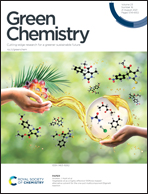A highly stable all-in-one photocatalyst for aryl etherification: the NiII embedded covalent organic framework†
Abstract
The efficient conversion of aryl bromides to the corresponding aryl alkyl ethers by dual nickel/photocatalysis has seen great progress, but difficulties of recycling the photosensitizer or nickel complexes cause problems of sustainability. Here, we report the design of a novel, highly stable vinyl bridge 2D covalent organic framework (COF) containing Ni, which combines the role of photosensitizer and reactive site. The as-prepared sp2c-COFdpy-Ni acts as an efficient heterogeneous photocatalyst for C–O cross coupling. The sp2c-COFdpy-Ni can be completely recovered and used repeatedly without loss of activity, overcoming the limitations of the prior methods. Preliminary studies reveal that strong interlayer electron transfer may facilitate the generation of the proposed intermediate sp2c-COFdpy-NiI in a bimolecular and self-sustained manner. This all-in-one heterogeneous photocatalyst exhibits good compatibility of substrates and tolerance of functional groups. The successful attempt to expand the 2D COFs with this new catalyst into photocatalytic organic transformation opens an avenue for photoredox/transition metal mediated coupling reactions.

- This article is part of the themed collection: 2021 Green Chemistry Hot Articles


 Please wait while we load your content...
Please wait while we load your content...